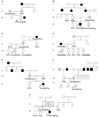Mild fasting hyperglycemia in children: high rate of glucokinase mutations and some risk of developing type 1 diabetes mellitus
- PMID: 19309449
- PMCID: PMC2864306
- DOI: 10.1111/j.1399-5448.2009.00499.x
Mild fasting hyperglycemia in children: high rate of glucokinase mutations and some risk of developing type 1 diabetes mellitus
Abstract
Background: Incidental hyperglycemia in children generates concern about the presence of preclinical type 1 diabetes mellitus (T1DM).
Objective: To genetically evaluate two common forms of maturity-onset diabetes of youth (MODY), the short-term prognosis in children with mild hyperglycemia, and a positive family history of diabetes mellitus.
Subjects: Asymptomatic children and adolescents (n = 14), younger than 15 yr, with fasting hyperglycemia, a positive family history of mild non-progressive hyperglycemia, and negative pancreatic autoantibodies were studied.
Patients and methods: Glucokinase gene (GCK) and hepatocyte nuclear factor 1 alpha gene (HNF1A) causing two common forms of MODY were sequenced. The clinical outcome was evaluated after a follow-up period of 2.8 +/- 1.3 yr.
Results: GCK mutations were present in seven children. The confirmation of this diagnosis allowed discontinuation of insulin in two families and oral medications in three families. Mutations of HNF1A were not detected in any of the families. During the follow-up period, all the GCK mutation carrier children remained asymptomatic without medication and the last hemoglobin A1c levels were 6.4 +/- 0.7%. In the GCK-negative children (n = 7), one developed T1DM, corresponding to 7.2% of the total group. Mild fasting hyperglycemia persisted during follow-up in four GCK-negative children and normalized in the remaining two.
Conclusions: The presence of mild persistent hyperglycemia in any patient without autoantibodies should lead to genetic analysis of GCK, particularly if there is a positive family history. Furthermore, those without GCK mutations should be followed with repeat autoantibody testing, and other genetic types of diabetes should be considered if hyperglycemia worsens.
Figures


Similar articles
-
Systematic assessment of etiology in adults with a clinical diagnosis of young-onset type 2 diabetes is a successful strategy for identifying maturity-onset diabetes of the young.Diabetes Care. 2012 Jun;35(6):1206-12. doi: 10.2337/dc11-1243. Epub 2012 Mar 19. Diabetes Care. 2012. PMID: 22432108 Free PMC article.
-
Glucokinase mutations in young children with hyperglycemia.Diabetes Metab Res Rev. 2006 Sep-Oct;22(5):348-55. doi: 10.1002/dmrr.622. Diabetes Metab Res Rev. 2006. PMID: 16444761
-
Maturity-onset diabetes of the young in children with incidental hyperglycemia: a multicenter Italian study of 172 families.Diabetes Care. 2009 Oct;32(10):1864-6. doi: 10.2337/dc08-2018. Epub 2009 Jun 29. Diabetes Care. 2009. PMID: 19564454 Free PMC article.
-
Recognition and Management of Individuals With Hyperglycemia Because of a Heterozygous Glucokinase Mutation.Diabetes Care. 2015 Jul;38(7):1383-92. doi: 10.2337/dc14-2769. Diabetes Care. 2015. PMID: 26106223 Review.
-
Insights from basic adjunctive examinations of GCK-MODY, HNF1A-MODY, and type 2 diabetes: A systemic review and meta-analysis.J Diabetes. 2023 Jun;15(6):519-531. doi: 10.1111/1753-0407.13390. Epub 2023 May 24. J Diabetes. 2023. PMID: 37226652 Free PMC article.
Cited by
-
Maturity-onset diabetes of the young: update and perspectives on diagnosis and treatment.Yeungnam Univ J Med. 2020 Jan;37(1):13-21. doi: 10.12701/yujm.2019.00409. Epub 2020 Jan 9. Yeungnam Univ J Med. 2020. PMID: 31914718 Free PMC article.
-
Genetic and clinical characteristics of Chinese children with Glucokinase-maturity-onset diabetes of the young (GCK-MODY).BMC Pediatr. 2018 Mar 6;18(1):101. doi: 10.1186/s12887-018-1060-8. BMC Pediatr. 2018. PMID: 29510678 Free PMC article.
-
Tunisian Maturity-Onset Diabetes of the Young: A Short Review and a New Molecular and Clinical Investigation.Front Endocrinol (Lausanne). 2021 Jul 29;12:684018. doi: 10.3389/fendo.2021.684018. eCollection 2021. Front Endocrinol (Lausanne). 2021. PMID: 34393998 Free PMC article. Review.
-
Cost-effectiveness of MODY genetic testing: translating genomic advances into practical health applications.Diabetes Care. 2014;37(1):202-9. doi: 10.2337/dc13-0410. Epub 2013 Sep 11. Diabetes Care. 2014. PMID: 24026547 Free PMC article.
-
GCK-MODY in the US Monogenic Diabetes Registry: Description of 27 unpublished variants.Diabetes Res Clin Pract. 2019 May;151:231-236. doi: 10.1016/j.diabres.2019.04.017. Epub 2019 May 4. Diabetes Res Clin Pract. 2019. PMID: 31063852 Free PMC article.
References
-
- Bhisitkul DM, Morrow AL, Vinik AI, Shults J, Layland JC, Rohn R. Prevalence of stress hyperglycemia among patients attending a pediatric emergency department. J Pediatr. 1994;124:547–551. - PubMed
-
- Steck AK, Eisenbarth GS. Genetic similarities between latent autoimmune diabetes and type 1 and type 2 diabetes. Diabetes. 2008;57:1160–1162. - PubMed
-
- American Diabetes Association. Diagnosis and classification of diabetes mellitus. Diabetes Care. 2004;27 Suppl. 1:S5–S10. - PubMed
-
- Lorini R, Alibrandi A, Vitali L, et al. Risk of type 1 diabetes development in children with incidental hyperglycemia: a multicenter Italian study. Diabetes Care. 2001;24:1210–1216. - PubMed
-
- Schatz DA, Kowa H, Winter WE, Riley WJ. Natural history of incidental hyperglycemia and glycosuria of childhood. J Pediatr. 1989;115:676–680. - PubMed
Publication types
MeSH terms
Substances
Grants and funding
LinkOut - more resources
Full Text Sources
Medical
Molecular Biology Databases
Miscellaneous

